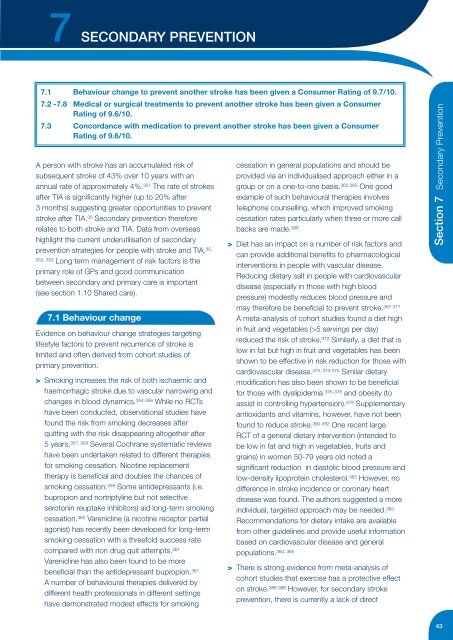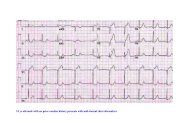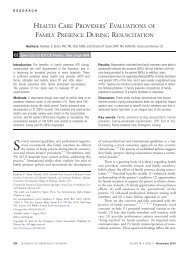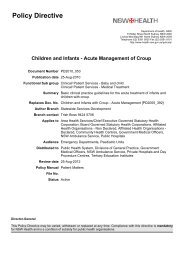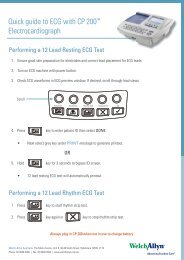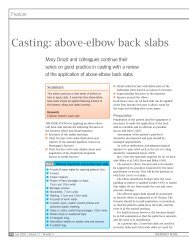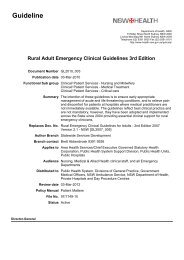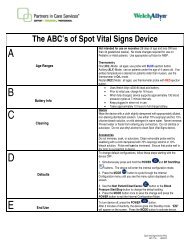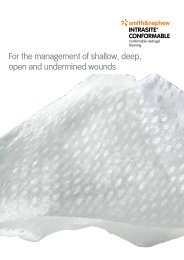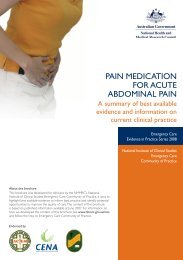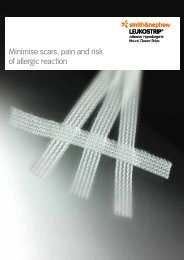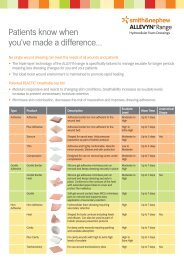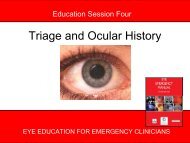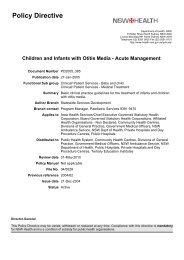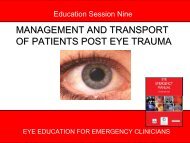Clinical Guidelines for Acute Stroke Management - Living on the EDge
Clinical Guidelines for Acute Stroke Management - Living on the EDge
Clinical Guidelines for Acute Stroke Management - Living on the EDge
You also want an ePaper? Increase the reach of your titles
YUMPU automatically turns print PDFs into web optimized ePapers that Google loves.
7 SECONDARY PREVENTION<br />
7.1 Behaviour change to prevent ano<strong>the</strong>r stroke has been given a C<strong>on</strong>sumer Rating of 9.7/10.<br />
7.2 -7.8 Medical or surgical treatments to prevent ano<strong>the</strong>r stroke has been given a C<strong>on</strong>sumer<br />
Rating of 9.6/10.<br />
7.3 C<strong>on</strong>cordance with medicati<strong>on</strong> to prevent ano<strong>the</strong>r stroke has been given a C<strong>on</strong>sumer<br />
Rating of 9.6/10.<br />
A pers<strong>on</strong> with stroke has an accumulated risk of<br />
subsequent stroke of 43% over 10 years with an<br />
annual rate of approximately 4%. 351 The rate of strokes<br />
after TIA is significantly higher (up to 20% after<br />
3 m<strong>on</strong>ths) suggesting greater opportunities to prevent<br />
stroke after TIA. 35 Sec<strong>on</strong>dary preventi<strong>on</strong> <strong>the</strong>re<str<strong>on</strong>g>for</str<strong>on</strong>g>e<br />
relates to both stroke and TIA. Data from overseas<br />
highlight <strong>the</strong> current underutilisati<strong>on</strong> of sec<strong>on</strong>dary<br />
preventi<strong>on</strong> strategies <str<strong>on</strong>g>for</str<strong>on</strong>g> people with stroke and TIA. 35,<br />
352, 353<br />
L<strong>on</strong>g term management of risk factors is <strong>the</strong><br />
primary role of GPs and good communicati<strong>on</strong><br />
between sec<strong>on</strong>dary and primary care is important<br />
(see secti<strong>on</strong> 1.10 Shared care).<br />
7.1 Behaviour change<br />
Evidence <strong>on</strong> behaviour change strategies targeting<br />
lifestyle factors to prevent recurrence of stroke is<br />
limited and often derived from cohort studies of<br />
primary preventi<strong>on</strong>.<br />
> Smoking increases <strong>the</strong> risk of both ischaemic and<br />
haemorrhagic stroke due to vascular narrowing and<br />
changes in blood dynamics. 354-356 While no RCTs<br />
have been c<strong>on</strong>ducted, observati<strong>on</strong>al studies have<br />
found <strong>the</strong> risk from smoking decreases after<br />
quitting with <strong>the</strong> risk disappearing altoge<strong>the</strong>r after<br />
5 years. 357, 358 Several Cochrane systematic reviews<br />
have been undertaken related to different <strong>the</strong>rapies<br />
<str<strong>on</strong>g>for</str<strong>on</strong>g> smoking cessati<strong>on</strong>. Nicotine replacement<br />
<strong>the</strong>rapy is beneficial and doubles <strong>the</strong> chances of<br />
smoking cessati<strong>on</strong>. 359 Some antidepressants (i.e.<br />
bupropi<strong>on</strong> and nortriptyline but not selective<br />
serot<strong>on</strong>in reuptake inhibitors) aid l<strong>on</strong>g-term smoking<br />
cessati<strong>on</strong>. 360 Varenicline (a nicotine receptor partial<br />
ag<strong>on</strong>ist) has recently been developed <str<strong>on</strong>g>for</str<strong>on</strong>g> l<strong>on</strong>g-term<br />
smoking cessati<strong>on</strong> with a threefold success rate<br />
compared with n<strong>on</strong> drug quit attempts. 361<br />
Varenicline has also been found to be more<br />
beneficial than <strong>the</strong> antidepressant bupropi<strong>on</strong>. 361<br />
A number of behavioural <strong>the</strong>rapies delivered by<br />
different health professi<strong>on</strong>als in different settings<br />
have dem<strong>on</strong>strated modest effects <str<strong>on</strong>g>for</str<strong>on</strong>g> smoking<br />
cessati<strong>on</strong> in general populati<strong>on</strong>s and should be<br />
provided via an individualised approach ei<strong>the</strong>r in a<br />
group or <strong>on</strong> a <strong>on</strong>e-to-<strong>on</strong>e basis. 362-365 One good<br />
example of such behavioural <strong>the</strong>rapies involves<br />
teleph<strong>on</strong>e counselling, which improved smoking<br />
cessati<strong>on</strong> rates particularly when three or more call<br />
backs are made. 366<br />
> Diet has an impact <strong>on</strong> a number of risk factors and<br />
can provide additi<strong>on</strong>al benefits to pharmacological<br />
interventi<strong>on</strong>s in people with vascular disease.<br />
Reducing dietary salt in people with cardiovascular<br />
disease (especially in those with high blood<br />
pressure) modestly reduces blood pressure and<br />
may <strong>the</strong>re<str<strong>on</strong>g>for</str<strong>on</strong>g>e be beneficial to prevent stroke. 367-371<br />
A meta-analysis of cohort studies found a diet high<br />
in fruit and vegetables (>5 servings per day)<br />
reduced <strong>the</strong> risk of stroke. 372 Similarly, a diet that is<br />
low in fat but high in fruit and vegetables has been<br />
shown to be effective in risk reducti<strong>on</strong> <str<strong>on</strong>g>for</str<strong>on</strong>g> those with<br />
cardiovascular disease. 370, 373-375 Similar dietary<br />
modificati<strong>on</strong> has also been shown to be beneficial<br />
<str<strong>on</strong>g>for</str<strong>on</strong>g> those with dyslipidemia 376-378 and obesity (to<br />
assist in c<strong>on</strong>trolling hypertensi<strong>on</strong>). 379 Supplementary<br />
antioxidants and vitamins, however, have not been<br />
found to reduce stroke. 380-382 One recent large<br />
RCT of a general dietary interventi<strong>on</strong> (intended to<br />
be low in fat and high in vegetables, fruits and<br />
grains) in women 50-79 years old noted a<br />
significant reducti<strong>on</strong> in diastolic blood pressure and<br />
low-density lipoprotein cholesterol. 383 However, no<br />
difference in stroke incidence or cor<strong>on</strong>ary heart<br />
disease was found. The authors suggested a more<br />
individual, targeted approach may be needed. 383<br />
Recommendati<strong>on</strong>s <str<strong>on</strong>g>for</str<strong>on</strong>g> dietary intake are available<br />
from o<strong>the</strong>r guidelines and provide useful in<str<strong>on</strong>g>for</str<strong>on</strong>g>mati<strong>on</strong><br />
based <strong>on</strong> cardiovascular disease and general<br />
populati<strong>on</strong>s.<br />
384, 385<br />
> There is str<strong>on</strong>g evidence from meta-analysis of<br />
cohort studies that exercise has a protective effect<br />
<strong>on</strong> stroke. 386-388 However, <str<strong>on</strong>g>for</str<strong>on</strong>g> sec<strong>on</strong>dary stroke<br />
preventi<strong>on</strong>, <strong>the</strong>re is currently a lack of direct<br />
Secti<strong>on</strong> 7 Sec<strong>on</strong>dary Preventi<strong>on</strong><br />
43


